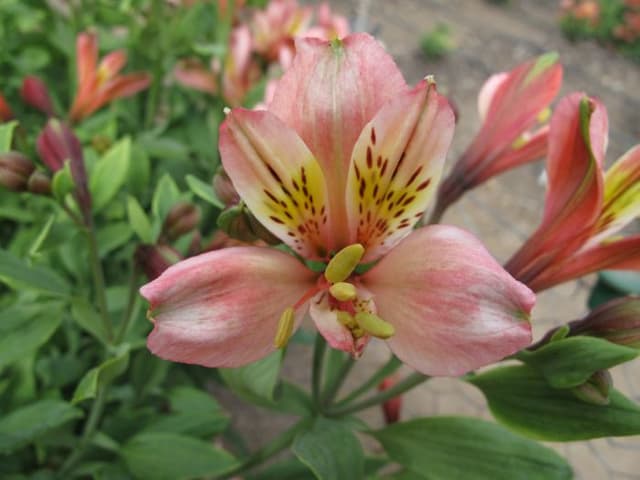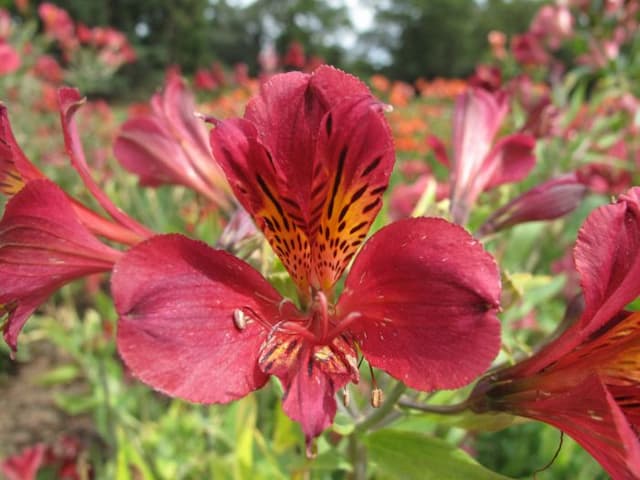Peruvian Lily Alstroemeria 'Tessa'

ABOUT
Alstroemeria 'Tessa' is a delightful perennial known for its striking flowers and is commonly referred to as the Peruvian lily or lily of the Incas. The plant features lush, green, lance-shaped leaves that grow in dense clumps, creating a backdrop for the showy floral display. Each stem produces clusters of trumpet-shaped flowers with six petals each, sporting a unique and often exotic look. The appearance of the flowers is remarkable; the Peruvian lily 'Tessa' variety comes in a vibrant color palette. The petals are usually a deep, rich pink or burgundy hue, with contrasting golden or cream streaks and speckles that add to their allure. The central parts of the flowers often have streaks or dots, which act as nectar guides for pollinators. What's truly captivating is the symmetrical pattern and the delicate textures on the petals. These blossoms form at the top of long, sturdy stems, which seem to rise elegantly above the foliage. The overall impression of Alstroemeria 'Tessa' is one of a bright and cheerful plant that adds a touch of drama and sophisticated color to any garden or floral arrangement. The plant blooms profusely, providing a long-lasting display of color throughout its flowering season.
About this plant
 Names
NamesFamily
Alstroemeriaceae
Synonyms
Peruvian Lily, Lily of the Incas, Parrot Lily
Common names
Alstroemeria 'Tessa'.
 Toxicity
ToxicityTo humans
The Peruvian lily, like all members of the Alstroemeria genus, can cause mild irritation if ingested. Although not considered highly toxic to humans, eating parts of the Peruvian lily can lead to symptoms such as nausea, vomiting, and diarrhea. Skin contact with the sap may also cause dermatitis in sensitive individuals.
To pets
The Peruvian lily is considered mildly toxic to pets such as cats and dogs. If ingested, it can cause gastrointestinal symptoms including vomiting and diarrhea. In most cases, the symptoms are not severe, and the prognosis is good with proper supportive care. However, it's still best to prevent your pets from ingesting this plant to avoid any potential discomfort.
 Characteristics
CharacteristicsLife cycle
Perennials
Foliage type
Deciduous
Color of leaves
Green
Flower color
Orange
Height
2-3 feet (60-90 cm)
Spread
1-2 feet (30-60 cm)
Plant type
Bulb
Hardiness zones
7
Native area
South America
Benefits
 General Benefits
General Benefits- Attractive Flowers: Alstroemeria 'Tessa' boasts striking, trumpet-shaped blooms that add a splash of color to any garden or floral arrangement.
- Long Blooming Season: The plant flowers prolifically over a long period, usually from late spring to fall, providing extended visual interest.
- Pollinator-Friendly: Alstroemeria 'Tessa' is known to attract bees and butterflies, supporting local ecosystems and promoting biodiversity.
- Low Maintenance: Once established, it requires minimal care, making it an excellent choice for both novice and experienced gardeners.
- Drought Tolerance: It is relatively drought-tolerant, which reduces the need for frequent watering and makes it suitable for dry climates.
- Versatile Use: Suitable for use in borders, containers, and as cut flowers, giving them a range of applications in landscapes and home decor.
- Cold Hardy: It can withstand cooler temperatures, making it a resilient choice for gardens in temperate regions.
 Medical Properties
Medical PropertiesThis plant is not used for medical purposes.
 Air-purifying Qualities
Air-purifying QualitiesThis plant is not specifically known for air purifying qualities.
 Other Uses
Other Uses- Edible Flowers: The blooms of the Alstroemeria, also known as Peruvian Lily, can be used as a decorative edible garnish for desserts and salads, though it's essential to ensure they haven't been treated with pesticides before consuming.
- Natural Insect Repellent: Some gardeners suggest that the Peruvian Lily's foliage may have mild insect repelling properties when planted in a mixed flower border.
- Photography Subject: The intricate and colorful flowers of the Peruvian Lily make them a favored subject for photographers and flower enthusiasts looking to capture natural beauty.
- Artistic Inspiration: Artists may use the vibrant flowers as inspiration for botanical drawings, paintings, and fabric designs due to their unique patterns and striking colors.
- Crafting: Dried Peruvian Lily flowers can be used in crafting, such as for making bookmarks, greeting cards, or in potpourri mixtures.
- Educational Tool: Alstroemeria 'Tessa' can be used in educational settings as an example of flower anatomy for botany students, showcasing the intricate designs that facilitate pollination.
- Symbolic Gifts: They carry various meanings, such as friendship and devotion, making them thoughtful gifts beyond their ornamental value.
- Dye Source: The vibrant pigments of the Peruvian Lily petals may be used as a natural dye for fabrics, though this is less common and may require quite a large number of petals to produce significant color.
- Texture in Floral Arrangements: Alongside their vivid colors, the Peruvian Lily's unique texture can add depth and interest to professional floral arrangements and bouquets.
- Cultural Ceremonies: In some cultures, Alstroemeria, particularly due to their longevity and variety of colors, may be used in ceremonial garlands or decorations for weddings or other significant events.
Interesting Facts
 Feng Shui
Feng ShuiThe Alstroemeria, also known as the Peruvian Lily, is not commonly referenced in traditional Feng Shui practice.
 Zodiac Sign Compitability
Zodiac Sign CompitabilityThe Peruvian Lily is not used in astrology practice.
 Plant Symbolism
Plant Symbolism- Devotion and Loyalty: Alstroemeria, commonly known as the Peruvian Lily or Lily of the Incas, represents strong mutual bond and commitment between people, indicating the enduring nature of one's relationships.
- Wealth and Prosperity: With their multiple blooms and long-lasting nature, Peruvian Lilies also symbolize abundance and wealth.
- Fortitude and Resilience: The ability of Alstroemeria to bloom and thrive for long periods is a symbol of strength and the ability to persist through hardships.
- Friendship: The intricate patterns on the petals of the Peruvian Lily signify the complexities and nuances of a deep friendship.
- Achieving Dreams: The growth pattern and upward reach of the Alstroemeria's flowers can be seen as a metaphor for striving to reach one's goals and aspirations.
 Water
WaterThe Peruvian Lily should be watered regularly to maintain evenly moist soil, especially during the growing season. Water the Peruvian Lily with about 1 inch of water per week, ensuring that the soil is damp but not waterlogged. During hot or dry periods, you may need to water twice a week. If grown in containers, they may require more frequent watering to prevent the soil from drying out. Be cautious not to overwater, as this can cause root rot. Always check the top inch of soil for dryness before watering again.
 Light
LightPeruvian Lilies thrive in a location that receives full sun to partial shade. Ideally, plant them in a spot that gets at least 6 hours of sunlight daily. However, in regions with very hot summers, they benefit from some afternoon shade to protect them from intense, direct sunlight.
 Temperature
TemperaturePeruvian Lilies prefer temperatures between 65 and 80 degrees Fahrenheit. They can tolerate a minimum temperature of around 50 degrees Fahrenheit and a maximum of about 85 degrees Fahrenheit. To ensure optimal growth, avoid placing the plant in areas where temperature extremes are common.
 Pruning
PruningPeruvian Lilies benefit from pruning to remove spent flowers and encourage additional blooming. Deadhead regularly by removing faded blooms. Cut back the foliage in late fall after the first frost to keep the plant tidy and healthy. The best time for extensive pruning is during the dormant period, often in the early spring before new growth starts.
 Cleaning
CleaningAs needed
 Soil
SoilThe best soil mix for Peruvian Lily 'Tessa' should be rich, well-draining, and slightly acidic to neutral, with a pH between 6.0 and 7.0. Combine two parts loam, one part perlite or coarse sand, and one part peat or organic compost to ensure proper drainage and fertility.
 Life cycle
Life cycleThe Alstroemeria 'Tessa', commonly known as Peruvian Lily, begins its life cycle as a dormant rhizome or tuberous root, which germinates when environmental conditions are favorable, typically in spring. The plant then enters a vegetative growth phase where leaves and stems develop rapidly. Following vegetative growth, the Peruvian Lily reaches the flowering stage, where vibrant blooms appear, attracting pollinators and potentially leading to the formation of seeds if pollination occurs. After the flowering period, which can last several weeks to months depending on conditions, the plant may enter a period of dormancy, particularly in colder climates or during winter months. Throughout its life, the Peruvian Lily can produce new shoots from the rhizome, enabling the plant to grow in size and spread. Finally, Alstroemeria 'Tessa' will die back to the ground at the end of its growing season, only to regrow from its rhizomes with the return of favorable conditions.
 Propogation
PropogationPropogation time
Spring to Summer
Alstroemeria 'Tessa', commonly known as Peruvian Lily, is best propagated through division, which is typically done in the spring or early summer to allow ample time for establishment before the colder months. Divide clumps by gently separating the tuberous roots, making sure each division has at least one or two growth points. These divisions can be replanted immediately, placing them at a depth of about 6 to 8 inches (15 to 20 centimeters) and spaced approximately 12 to 24 inches (30 to 60 centimeters) apart to ensure enough room for growth. Water the newly planted divisions deeply to help settle the soil around the roots and provide a consistent moisture level as they establish.


![Peruvian lily [Inca Glow]](/_next/image?url=https%3A%2F%2Fplants-admin.emdemapps.com%2Fimages%2Fplants%2F%2Fimages%2F604b5e99e48d9.png&w=640&q=75)
![Peruvian lily [Inca Smile]](/_next/image?url=https%3A%2F%2Fplants-admin.emdemapps.com%2Fimages%2Fplants%2F%2Fimages%2F604b5cad8fa91.png&w=640&q=75)
![Peruvian lily [Inticancha Passion]](/_next/image?url=https%3A%2F%2Fplants-admin.emdemapps.com%2Fimages%2Fplants%2F%2Fimages%2F604b5f7a78c8d.png&w=640&q=75)



![Peruvian lily [Summer Breeze]](/_next/image?url=https%3A%2F%2Fplants-admin.emdemapps.com%2Fimages%2Fplants%2F%2Fimages%2F604b6401573b7.png&w=640&q=75)
